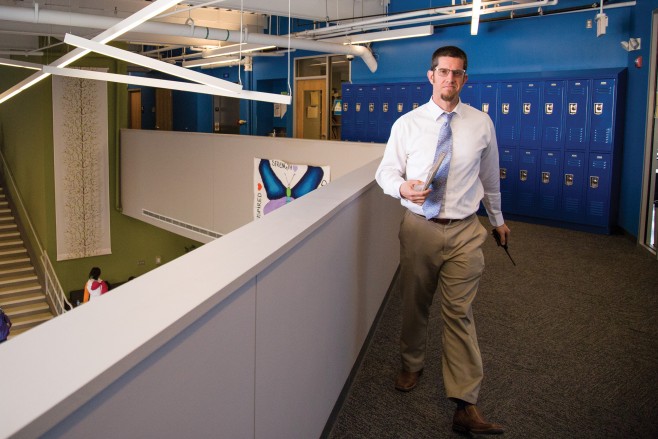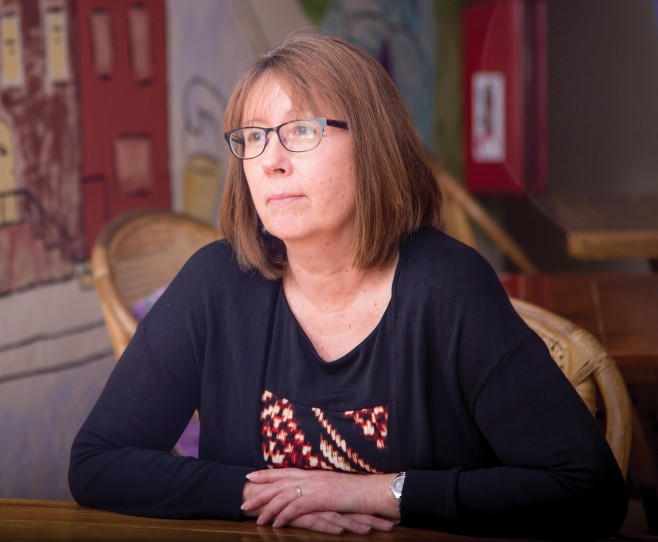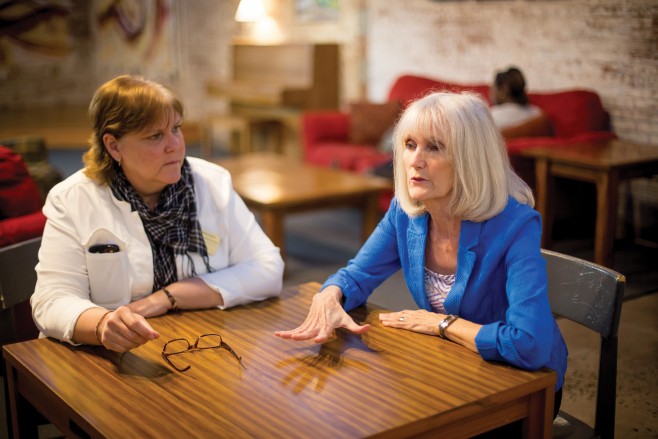
Danny Malec, MA ’05, is assistant principal for restorative practices at an inner city school in Washington D.C. (Photo by Kara Lofton)
Three years ago, Danny Malec, MA ’05 (conflict transformation), was hired to help E.L. Haynes High School in Washington D.C. break free from the disciplinary rut of suspensions and expulsions that plague so many American schools.
Now the school’s assistant principal for restorative practices, Malec and his colleagues have begun using techniques such as restorative conferencing to deal with student discipline. This represents a dramatic departure from the traditional mindset that responds to a fight, for example, with a punishment like suspension that excludes students from the classroom. Instead, a restorative approach might involve a meeting between anyone involved in or affected by the fight, during which they would discuss who was harmed and agree on a way of repairing that harm.
Malec has also been using circle processes and other tools of restorative justice to build a more positive culture in the school by emphasizing healthy relationships and inviting good behavior rather than only punishing the bad.
By some measures, the effort has been successful. Within two years, for example, the school reduced its suspensions by more than 50%, Malec says. And there have been zero expulsions this school year (as of late spring, as Crossroads went to press), down from close to 10 the year before.
On the opposite side of the country in another inner-city school, Augustus Hawkins High School in Los Angeles, Joseph Luciani, MA ’13 (conflict transformation) has been working in a very similar role as the school’s restorative practices specialist. In less than two years, he says, tangible benefits include fewer fights and fewer students skipping school.
For many years, people working in restorative justice have recognized that the theories and practices first developed as alternatives to the criminal justice system have much to offer schools and education. And increasingly, more and more people like Malec and Luciani working in schools have been demonstrating the effectiveness of that approach.
As a result, more and more teachers, administrators and school systems have begun to take notice. Once a strange and novel thing to talk about in the context of education, restorative justice is now “right on the cusp,” Malec says, of becoming a new buzzword in American education.
On one hand, Malec and his colleagues are thrilled by the coming opportunities to use restorative practices more widely in education. But at the same time, they fear that if restorative justice is improperly or ineffectively applied in schools, it will simply become yet another failed “next best thing” in education.
“Everybody knows the term ‘restorative justice’ these days,” says Judy Mullet ’73, a professor of psychology at EMU who specializes in restorative discipline. “The worry is that it will be a flash in the pan.”

Lorraine Stutzman Amstutz ’81, co-wrote with Judy Mullet ’73 The Little Book of Restorative Discipline for Schools. (Photo by Jon Styer)
Institutional culture issues
Schools that think they have a discipline problem, Mullet continues, often actually have an institutional culture problem. Fixing that requires change at all levels, including personal and relational changes within and between staff – a challenging, lengthy process for overworked educators accustomed to step-by-step plans. But reducing restorative justice to a few sets of practices without investing in a longer-term process of personal and school-wide change, say several people interviewed for this article, sets it up for failure.
“We like quick fixes, but I don’t think that in any way creates systemic change,” says Lorraine Stutzman Amstutz ’81, restorative justice coordinator with Mennonite Central Committee. “There’s that danger that schools are doing the same thing they were doing before and just using different language.”
Communicating the message that restorative justice involves a long process of institutional change is one of the biggest challenges that Malec and Luciani face in their schools. And so, despite the reduced suspensions and expulsions he’s helped his inner-city high school achieve, Malec says there is still lots more work to do:
Culture takes time to change. A lot of our students have grown up being suspended. They know that really well. What they don’t know well is how to sit down and repair damaged relationships. It’s the same with the adults in the building. It’s a foreign culture for all of us, and that takes time
Restorative justice is about slowing down, it’s about listening to each other, it’s about involving a wider range of people in the process – the whole structure kind of has to shift with restorative practices, which makes it extra difficult and kind of scares me a little bit. Unless the structure changes, people are going to keep doing the same thing they were doing and call it restorative justice.
Luciani has likewise found himself telling others at his school that the reduced suspensions achieved with the help of restorative practices are just the start.
Based on relationships
“People see this as another program … that’s going to fix the behavior issues of students,” Luciani says. “And I’m always saying, ‘Restorative justice is not a program. It’s a culture change.’ That takes time. And it takes an understanding of what exactly we want to change. It’s based on relationships. It’s based on connecting people with each other and their inner selves…. I don’t think that everybody understands that yet.”
At Lancaster Mennonite School in southeastern Pennsylvania, that long, gradual process change has “been a real blessing” for the school, says assistant superintendant Miles Yoder ’79.
“I can’t say enough positive things about it,” he says. “Restorative justice changes people’s hearts.”
As has been the case in the schools where Malec and Luciani work, application of restorative justice practices at Lancaster Mennonite has drastically reduced its use of suspension and detention. The deeper shift of culture is evident, Yoder continues, in the way that faculty and staff have begun placing greater responsibility on students to solve their own problems, and using the basic questions of restorative justice – Who was harmed? How can that be repaired? – before resorting to traditional punishments.
Yoder says that process of cultural change has been 15 years in the making at Lancaster Mennonite School, and has required constant support along the way. The fact that this sort of long-term institutional stability isn’t always present in other school systems is one of the major challenges to the successful application of restorative justice in education.
“EMU has been very helpful by providing our initial training and professional development to allow us to continue to use it,” says Yoder.

EMU education professor Kathy Evans (left) is in charge of EMU’s master’s concentration and graduate certificate in restorative justice in education. Judy Mullet ’73 is a psychology professor who specializes in restorative discipline.
Pioneering a grad program
In the 2014-15 academic year, EMU’s graduate education program became the first in the country to offer a master’s concentration and a graduate certificate in restorative justice in education.
“People are hungry for good instruction about what restorative justice looks like in schools, and how they can be better prepared to be restorative justice educators,” said EMU education professor Kathy Evans in an interview last year, soon before the launch of the new program, which she was instrumental in starting.
The notion of using restorative justice in a school was still relatively unusual in 2004, when Dawn Lehman, MA ’03 (conflict transformation), began working on a two-year restorative justice project in three public schools around Pittsburgh, Pennsylvania.
When she joined the effort – run by a Pittsburgh nonprofit in partnership with the schools – the groundwork had been laid, the administration was eager, and things got off to a great start. In her experience, teaching the values and practices of restorative justice was the easy part.
“It makes sense. It’s almost too obvious,” she recalls. “And yet there’s this contradiction in that while people will agree it makes perfect sense, there still seems to be systemic obstacles that are hard to overcome.”
One of the biggest systemic obstacles is funding. In Lehman’s case, it ran out after two years, and the program ended (Lehman now works for a victim-offender dialogue program with the Pittsburgh juvenile court system).
And even during that two-year period of time, staff turnover was another significant systemic challenge. During the course of the project, new administrators took over at two of the three schools. And while none of them opposed the work, none were as invested in it as their predecessors who’d gotten it started.
Lehman has bumped into people who have positive memories of her work in the schools 10 years ago, yet she doubts that restorative justice is being practiced in them now.
Planting seeds
Looking back on it all, Lehman compares the project to “planting seeds” with the potential to bloom far down the road, long after specific projects or initiatives have run their course.
“I just fundamentally believe in the value of engaging with people rather than making decisions for them,” she says. “Any time you hold a process in line with restorative principles, you’re fundamentally modeling respectful human interaction…. You’re engaging with people respectfully. Those are the moments that can be life-changing for people. That’s tremendously significant.”
Perhaps a decade from now, restorative justice will have helped transform classrooms, schools and lives across the world. Or perhaps there will be dozens more stories like Lehman’s, of promising work that came to an end. Perhaps a lot of both.
In any case, Mullet says, change is messy. The kind of holistic, lasting change to relationships that restorative justice can bring to schools is messier yet, and requires time and resources.
“This reality check invites freedom to learn from mistakes and connect for the long haul,” she says.